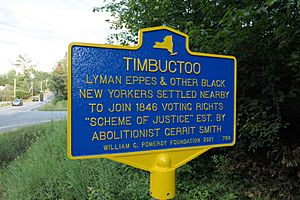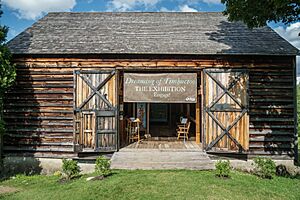Timbuctoo, New York facts for kids
Timbuctoo, New York, was a small farming community in the Adirondack Mountains of Upstate New York. It was started in the mid-1800s by African-American families. They wanted to build new lives there. This area is now close to Lake Placid.
Timbuctoo has become a famous part of New York State history. The name "Timbuctoo" was given to it later by John Brown. Today, the land is covered by forests again. We don't know exactly where the houses were. There are no old buildings or photos left. The only thing that remains is the house of John Brown, who taught farming there. His barn now has an exhibit about Timbuctoo.
The story of Timbuctoo is about trying to make things right. At the time, black men in New York could only vote if they owned a lot of property. A rich man named Gerrit Smith wanted to help. He gave land to black men so they could vote. This project aimed to turn city workers into landowners. But it was very hard work. The land was remote and the weather was very cold. Only one family stayed there permanently.
Contents
Why Was Timbuctoo Created?
In 1821, New York State made a rule. It said that free black men had to own land worth at least $250 to vote. White men did not have this rule. In 1846, people voted on whether to remove this rule. But it failed by a lot of votes.
Gerrit Smith, a very rich man who was against slavery, wanted to fix this. In 1846, he announced a big plan. He would give away 120,000 acres of land to 3,000 black New Yorkers. Each person would get 40 acres.
This plan had several goals:
- It gave black people a chance to own land and be self-sufficient.
- It helped black men get the right to vote.
- It offered a new life away from crowded cities.
- It was a way to escape slave catchers. These people would try to kidnap free black people and sell them into slavery.
Famous leaders like Frederick Douglass and Henry Highland Garnet helped Smith. They told people about the land and encouraged them to move. Smith wanted people who were responsible and had good morals.
Similar projects were started in other places nearby. These included Vermontville and Blacksville.
Life in the Adirondacks
The first people moved to Timbuctoo in early 1848. One of the first problems was finding their land. Some settlers were tricked and given less valuable land. It was important to have someone who could read maps and directions.
White people already living in the area were not always welcoming. They did not want black families to settle there. Some even threatened those who helped the new settlers. They said they would not live in a town with black people.
At its busiest, about 50 families lived in the Timbuctoo area. But by 1850, the census showed fewer than 30 families.
In 1848, Gerrit Smith gave Willis Hodges 200 acres near Loon Lake. Ten families settled there and called it Blacksville. But this community broke up after two very harsh winters. Farming in the Adirondack Mountains was extremely difficult. Many settlers did not have experience building houses or farming in such cold weather. Also, some white neighbors were not friendly. These challenges made most people leave.
In 1849, John Brown moved his family to North Elba. He wanted to help the Timbuctoo project grow. John Brown was a strong opponent of slavery.
Challenges of the Land
Gerrit Smith seemed very generous by giving away so much land. But he later said he was "perhaps a better land-reformer in theory than in practice." The land he gave away was often land he couldn't sell. It was undeveloped and cost him a lot in taxes. Some people said he was just trying to look good by giving away useless land.
Smith believed that black people needed to be "better than the whites." He thought they should stop living in cities and take on "menial occupations." He described the Adirondack land as having "long winters, deep snows and thin soil." He said that white men there had to work very hard to survive. He thought black people should work even harder.
How Long Did Timbuctoo Last?
By 1857, fewer than 50 families had actually moved to the land Smith gave them. Many others had sold their land or lost it because they couldn't pay taxes.
The 1850 U.S. Census showed only thirteen black families in North Elba. By 1870, only a few families remained. Only the Epps family stayed permanently. Lyman Epps became well-known in the area. He played a big part in the early growth of Lake Placid village.
Most people who received land were not used to farm work. Many were city people like shoemakers or barbers. They found it very hard to clear land and build homes. The weather was also extremely cold, with long winters and short growing seasons. Starting a farm also needs money for seeds, tools, and animals. The settlers often did not have this money.
John Brown did create a successful farm in North Elba. But he had grown sons to help him. He also had some money to start with.
Who Lived in Timbuctoo?
Lyman Epps and His Family
Lyman and Anne Epps were said to be fugitive slaves. They moved from Troy, New York, to North Elba with their two children. The Epps family stayed in North Elba for over 100 years. Lyman Epps became a music teacher and a community leader. He helped start the local Sunday school, the Lake Placid Public Library, and the Lake Placid Baptist Church. He made a living raising sheep and farming.
Lyman Epps Sr. died in 1897 at age 83. His son, Lyman Epps Jr., was the last person alive who had seen John Brown's funeral. He shared his memories with people. Lyman Epps Jr. died in 1942 at 102 years old. A marker at his grave is the only visible sign of Timbuctoo's existence.
John Thomas's Brave Story
John Thomas was born into slavery in Virginia. He escaped around 1839 to Philadelphia and then to Troy, New York. He married Mary Vanderhyden and started a family. John accepted Gerrit Smith's land offer.
Later, people who hunted escaped slaves came for him in the Adirondacks. But the white men in the settlement protected him. They warned the bounty hunters that Thomas was armed and would fight to stay free. The bounty hunters left and never came back. John Thomas lived the rest of his life in Vermontville, not far from Timbuctoo. He died in 1894 at 83.
What Remains Today?
John Brown's farmhouse and barn are the only buildings left from the Timbuctoo project. All other signs of the settlement are gone. You won't find Timbuctoo on maps of the Adirondacks. A historical marker was placed in Lake Placid in June 2022.
The story of Timbuctoo has inspired many artists.
- The novel Cloudsplitter by Russell Banks includes a part about Timbuctoo.
- There's a film called Searching for Timbuctoo. It tells the history of the community. It also follows archaeologists who are trying to find the settlement's exact location.
- Voice of Timbuctoo is a musical piece.
- Promised Land: An Adirondack Folk Opera is another musical work in progress.
"Dreaming of Timbuctoo" Exhibit
In 2001, an exhibit called "John Brown 'Dreaming of Timbuctoo'" opened. It tells the story of the black homesteaders who received land in the Adirondacks. This exhibit has traveled to many museums and colleges. Since 2016, the John Brown Farm State Historic Site has been its permanent home.
Blues at Timbuctoo Festival
Every year, a "Blues at Timbuctoo" festival is held in Lake Placid. It takes place at the historic John Brown Farm. The festival features music and discussions about race relations. It started in 2015.




